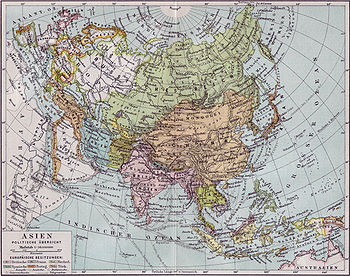Khmer Republic and the War (1970–75)
Map of Asia in 1890
| This section needs additional citations for verification. (January 2010) |
Hanoi rejected the new republic's request for the withdrawal of NVA troops. In response, the United States moved to provide material assistance to the new government's armed forces, which were engaged against both CPK insurgents and NVA forces. The North Vietnamese and Viet Cong forces, desperate to retain their sanctuaries and supply lines from North Vietnam, immediately launched armed attacks on the new government. The North Vietnamese quickly overran large parts of eastern Cambodia, reaching to within 15 miles (24 km) of Phnom Penh. The North Vietnamese turned the newly won territories over to the Khmer Rouge. The king urged his followers to help in overthrowing this government, hastening the onset of civil war.[125]
In April 1970, US President Richard Nixon announced to the American public that US and South Vietnamese ground forces had entered Cambodia in a campaign aimed at destroying NVA base areas in Cambodia (see Cambodian Incursion).[126] The US had already been bombing Vietnamese positions in Cambodia for well over a year by that point. Although a considerable quantity of equipment was seized or destroyed by US and South Vietnamese forces, containment of North Vietnamese forces proved elusive.
The Khmer Republic's leadership was plagued by disunity among its three principal figures: Lon Nol, Sihanouk's cousin Sirik Matak, and National Assembly leader In Tam. Lon Nol remained in power in part because none of the others were prepared to take his place. In 1972, a constitution was adopted, a parliament elected, and Lon Nol became president. But disunity, the problems of transforming a 30,000-man army into a national combat force of more than 200,000 men, and spreading corruption weakened the civilian administration and army.
The Khmer Rouge insurgency inside Cambodia continued to grow, aided by supplies and military support from North Vietnam. Pol Pot and Ieng Sary asserted their dominance over the Vietnamese-trained communists, many of whom were purged. At the same time, the Khmer Rouge (CPK) forces became stronger and more independent of their Vietnamese patrons. By 1973, the CPK were fighting battles against government forces with little or no North Vietnamese troop support, and they controlled nearly 60% of Cambodia's territory and 25% of its population.
The government made three unsuccessful attempts to enter into negotiations with the insurgents, but by 1974, the CPK was operating openly as divisions, and some of the NVA combat forces had moved into South Vietnam. Lon Nol's control was reduced to small enclaves around the cities and main transportation routes. More than two million refugees from the war lived in Phnom Penh and other cities.
On New Year's Day 1975, Communist troops launched an offensive which, in 117 days of the hardest fighting of the war, caused the collapse of the Khmer Republic. Simultaneous attacks around the perimeter of Phnom Penh pinned down Republican forces, while other CPK units overran fire bases controlling the vital lower Mekong resupply route. A US-funded airlift of ammunition and rice ended when Congress refused additional aid for Cambodia. The Lon Nol government in Phnom Penh surrendered on 17 April 1975, just five days after the US mission evacuated Cambodia.[127]
The relationship between the massive carpet bombing of Cambodia by the United States and the growth of the Khmer Rouge, in terms of recruitment and popular support, has been a matter of interest to historians. Some historians have cited the US intervention and bombing campaign (spanning 1965–1973) as a significant factor leading to increased support of the Khmer Rouge among the Cambodian peasantry. However, Pol Pot biographer David Chandler argues that the bombing "had the effect the Americans wanted – it broke the Communist encirclement of Phnom Penh".[128] Peter Rodman and Michael Lind claimed that the US intervention saved Cambodia from collapse in 1970 and 1973.[129][130] Craig Etcheson agreed that it was "untenable" to assert that US intervention caused the Khmer Rouge victory while acknowledging that it may have played a small role in boosting recruitment for the insurgents.[131] William Shawcross, however, wrote that the US bombing and ground incursion plunged Cambodia into the chaos Sihanouk had worked for years to avoid.[132]
The Vietnamese intervention in Cambodia, launched at the request of the Khmer Rouge,[133] has also been cited as a major factor in their eventual victory, including by Shawcross.[134] Vietnam later admitted that it played "a decisive role" in their seizure of power.[135] China "armed and trained" the Khmer Rouge during the civil war and continued to aid them years afterward.[136]

No comments:
Post a Comment